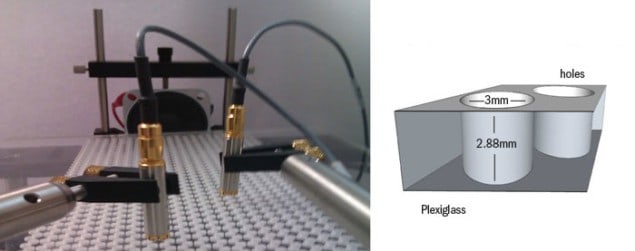
It may sound inconceivable, but two physicists in Spain claim to have made an acoustic version of the wonder material graphene by simply drilling a honeycomb pattern of holes into a plastic sheet. Daniel Torrent and José Sánchez-Dehesa of the Polytechnic University of Valencia say they have spotted “Dirac cones” – a characteristic feature in the electronic band structure of graphene – in sound waves that propagate on the surface of the plastic. While much more work is required before practical applications could emerge from what the researchers call an “acoustic analogue of graphene”, the material could be used to improve acoustical systems or even gain a better understanding of graphene itself.
Since graphene was discovered in 2004, this 2D honeycomb lattice of carbon has been found to have a wealth of fascinating electronic properties. Many of these arise from the fact that graphene is a semiconductor with zero energy gap between its valence and conduction bands. Near where the two bands meet, the relationship between the energy and momentum of the electron is described by the Dirac equation and resembles that of a photon. These bands, called Dirac cones, enable electrons to travel through graphene at extremely high speeds.
Torrent and Sánchez-Dehesa decided to find out if an acoustic analogue to Dirac cones could exist. They did this by first calculating the properties of sound waves travelling on the surface of poly(methylmethacrylate) – also known as Perspex or Plexiglas – onto which holes had been bored to create a honeycomb lattice. The researchers were particularly interested in the dispersion relation of the sound waves, which is the relationship between the energy of a sound wave and its momentum.
Definitively Dirac
The calculations, which revealed the existence of a Dirac point and Dirac cones, suggest that the surface acoustic waves are best described by the Dirac equation. In particular, the model predicts the existence of surface acoustic waves with a specific Dirac frequency and Dirac velocity that should propagate with ease through the material without scattering.
To look for these waves, Torrent and Sánchez-Dehesa took a sheet of Plexiglas measuring 300 mm by 100 mm and bored 1113 holes in it to create a honeycomb pattern. Each hole had a diameter of 3 mm and depth of 2.88 mm, with the distance between holes being 3.33 mm. As illustrated in the image above, this resulted in the removal of a large amount of material, leaving behind a trellis-like structure.
The sheet was then connected to a loudspeaker and the sound was measured using microphones at two different locations. The physicists blasted the material with short pulses of sound with a central frequency of 22 kHz and a pulse width of about 5 kHz – chosen because the predicted Dirac frequency of the material lay within the pulse.
Sharp dip
Torrent and Sánchez-Dehesa found that the “phase delay” – the time difference in the arrival of the sound waves at each microphone – dipped sharply at about 22 kHz, which they say corresponds to the vertex of the Dirac cone. They also noticed that the dispersion relation of the waves, as calculated from their experiment, revealed a Dirac cone at about 22 kHz, as expected from theory. In particular, they found a linear relationship between momentum and energy near the Dirac point, which is a hallmark of a Dirac cone.
Nicholas Fang of the Massachusetts Institute of Technology in the US describes the work as “exciting” and told physicsworld.com that he agrees with Torrent and Sánchez-Dehesa’s claim of having identified a Dirac cone. “This is quite impressive, as from the theories, to observe such a Dirac cone in an acoustic system would require a precise shape and volume fraction of the structures,” he says.
Both Fang and the original researchers say that it is too early to know if materials with Dirac cones could be put to practical use. One possibility, however, could be to use them for acoustic lenses that can collect sound without losing any of it to reflection.
Torrent and Sánchez-Dehesa are now doing experiments designed to confirm that the acoustic waves travel unimpeded across the material – much like Dirac electrons in graphene. Indeed, Sánchez-Dehesa believes that similar materials could be used to simulate the electronic properties of graphene using sound. This could be useful because important properties such as lattice parameters can be easily changed in Plexiglas – but not in graphene itself.
The work is described in Physical Review Letters.



